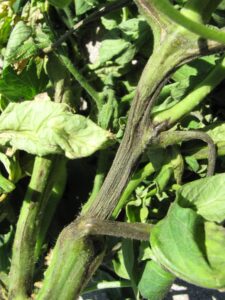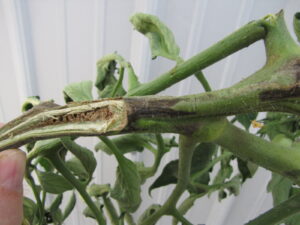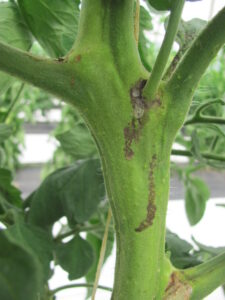Tomato pith necrosis is a bacterial disease of tomatoes that occurs sporadically, usually in greenhouses or high tunnels. While this disease can kill or at least ruin marketable yield on tomatoes, the disease usually affects perhaps only a handful of plants in a greenhouse. That is, the disease does not seem to spread beyond the initial affected plants.
The first symptoms one might observe of pith necrosis are the dark and twisted stems (Figure 1). These symptoms may become sufficiently severe to cause the wilting and collapse of the plant. Leaves may turn chlorotic as a result of infection. When the stems are cut open, a dark necrosis may be observed. Continued infection of the stem may rot away much of the tissue resulting only a chambered pith remaining (Figure 2). Affected plants are not necessarily next to each other. Before the stems become twisted, one may observe dark, irregular stains on the outside of the stems (Figure 3).
Pith necrosis is caused by a bacterium. In the lab, I can readily observe the bacteria when I cut open discolored skins of the stem and place them under a microscope.
Because the plant has a discoloration in the stem, it is sometimes confused with bacterial canker, a much more serious disease.
It is not clear how pith necrosis spreads or enters the tomato plant, but it is probably best to remove affected plants and avoid using pruning equipment on diseased plants. When removing diseased plants, it is always best to leave as little of the plant behind as possible. A landscape cloth covering can help to keep crop residue out of the soil. Remove the plants well away from the production area.
Perhaps since pith necrosis is not economically important and does not appear to spread quickly, not much is listed for the management guidelines. To manage tomato pith necrosis, avoid low night temperatures and excessive nitrogen levels; reduce high humidity in the greenhouse or high tunnel. General pest management guidelines can be found in the Midwest Vegetable Production Guide for Commercial Growers 2023 (mwveguide.org).
Tomato pith necrosis is not usually a severe disease and does not usually cause economic damage. But it is important to obtain and accurate diagnosis of this disease. Send samples to the Purdue Plant and Pest Diagnostic Laboratory or contact Dan Egel (egel@purdue.edu).


